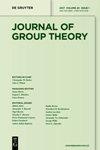Sublinearly Morse boundary of CAT(0) admissible groups
IF 0.5
3区 数学
Q4 MATHEMATICS
引用次数: 0
Abstract
We show that if 𝐺 is an admissible group acting geometrically on aCAT(0)可接纳群的次线性莫尔斯边界
我们证明,如果𝐺 是一个几何作用于 CAT ( 0 ) \operatorname{CAT}(0) 空间 𝑋 的可容许群,那么𝐺 是一个层次双曲空间,它的𝜅-Morse 边界 ( ∂ κ G 、ν ) (\partial_{k\appa}G,\nu) 是 ( G , μ ) (G,\mu) 的泊松边界模型,其中 𝜈 是与𝜇驱动的随机漫步相关的命中率。
本文章由计算机程序翻译,如有差异,请以英文原文为准。
求助全文
约1分钟内获得全文
求助全文
来源期刊

Journal of Group Theory
数学-数学
CiteScore
1.00
自引率
0.00%
发文量
45
审稿时长
6 months
期刊介绍:
The Journal of Group Theory is devoted to the publication of original research articles in all aspects of group theory. Articles concerning applications of group theory and articles from research areas which have a significant impact on group theory will also be considered.
Topics:
Group Theory-
Representation Theory of Groups-
Computational Aspects of Group Theory-
Combinatorics and Graph Theory-
Algebra and Number Theory
 求助内容:
求助内容: 应助结果提醒方式:
应助结果提醒方式:


